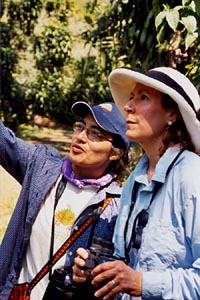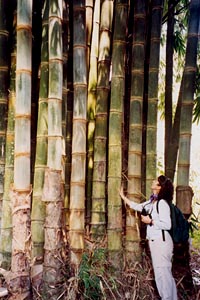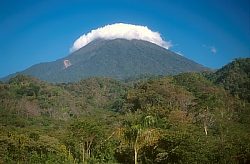Trip Report: Customized Birding Tour - Los Tarrales
(28-31 January 2004)
Tour leader: Claudia Avendaño
Participants: Steve and Elizabeth Welch, and Barbara Chaves
28 January 2004
This morning I met Steve, Lyz and Barbara at their hotel in Antigua Guatemala, and then we began our trip to Los Tarrales Nature Reserve, located on the South slope of the Atitlan Volcano. The time on the road was very entertaining, not just for getting to know each other better, but for enjoying the landscape on the way: Shade coffee plantations, tropical trees, and the Fuego Volcano, which was showing some activity expulsing smoke from the crater! Barbara was the one initiating Lyz and Steve in birdwatching, but it would be the first time birding in a tropical forest for all of them. The visit to Los Tarrales turned out to be just a perfect beginning!
After a cold drink at Los Tarrales we took one of the trails of the reserve and began looking for birds. Very soon we were surprised by the bright colors of the Baltimore Oriole (Icterus galbula) and many Red-legged Honeycreepers (Cyanerpes cyaneus), both in a group of females, young and adult males. These two species were easily seen in groups during the rest of the tour. The Golden-fronted Woodpecker (Centurus aurifrons) called for us and then let us see him creeping up on a branch. Barbara and Lyz took a good look at a hummingbird that I did not get to see, but their description of it let me know that it was a Cinnamon Hummingbird (Amazilia rutila), and now they know how precise the name is for this species! Our walk took us to the border of a shade coffee plantation, and there we saw the Masked Tityra (Tityra semifasciata) and the Altamira Oriole (Icterus gularis).
On our first lunch we tasted a Guatemalan typical dish, and this one left us wishing for more to come on the next days! After lunch we decided to drink a coffee close to the garden, and the White-throated Magpie-Jay (Calocitta formosa) was waiting for us on the front tree, about 4 meters away! This afternoon we decided to take another trail through one of the ornamental plantations, and we had great and easy observations of migratory birds: Swainson’s Thrush (Catharus ustulatus), Summer Tanager (Piranga rubra), males and females of Rose-breasted Grosbeak (Pheucticus ludovicianus) and of Ruby-throated Hummingbird (Archilochus colubris). We saw these species many times more and our group was just delighted with how easily they could find them and really observe them! The Clay-colored Robins (Turdus grayi) sang for us announcing the beginning of the breeding season, while the Rufous-naped Wrens (Campylorhynchus rufinucha) showed us how a nest is made and conveniently located! The Tennessee Warbler (Vermivora peregrina) was moving on low branches and a Black Vulture (Coragyps atratus) was perching for a long time on a tree nearby.
29 January 2004

© Steve Welch.
We had a very early morning coffee and then we went by car to the entrance of a trail higher on the volcano slope. On the way the lights of the car let us see a couple of red lights on the road: The eyes of the Parauque (Nyctidromus albicollis), which we could see clearly with our binoculars. The Lesser Nighthawk (Chordeiles acutipennis) was flying above us that morning several times on our first view point on the road. We were standing on the edge of the shade coffee, as the men and women living in the farm were walking up to pick coffee in the area. Meanwhile, the dawn chorus was joined by the loud whistles and rattles of the Highland Guan (Penelopina nigra). We heard also the the Crested Guan (Penelope purpurascens), the Laughing Falcon (Herpethoteres cachinnans) and the Spotted Wood-Quail (Odontophorus guttatus). Then we began walking downslope along a small trail through humid montane forest, where the Squirrel Cuckoo (Piaya cayana) welcomed us. There we found migratory birds like the Magnolia Warbler (Dendroica magnolia) and American Redstart (Setophaga ruticilla). We also identified the Tody Motmot (Hylomanes momotula), Yellow-throated Euphonia (Euphonia hirundinacea) , Gray-breasted Wood-Wren (Henicorhina leucophrys) and the Blue-tailed Hummingbird (Amazilia cyanura). Even though the forest canopy can make it a little difficult to find the moving birds, our group was patient and practiced to observe the important details of the species to be able to identify them. This day we also had a good example of how noisy a lek of of Cinnamon Hummingbirds (Amazilia rutila) can be, since they were perching and singing right above us. Along the trail we saw many plants flowering in the wild, we learned about their uses and recognized some of them from back home.
In the afternoon we met with a local guide who took us through the ornamental plants and exotic flowers plantations, which are one of the economical supports in the nature reserve. He explained how the plants and flowers need to be processed for selling. We also had some good observations of birds along the way, like the Yellow-winged Tanager (Thraupis abbas), Blue-gray Tanager (Thraupis episcopus) and more Red-legged Honeycreepers (Cyanerpes cyaneus). By the 3rd day of the tour it was very easy for the group to spot and identify these species. The man guiding us through the plantations is familiar with the CAYAYA BIRDING staff, so he profits on learning more about birds when he is with one of our groups.
30 January 2004

© Steve Welch.
When you want to learn about birds, nature itself may give you the chance to find two similar species standing together, just to make sure you learn their differences well. This is what happened when we observed the Social Flycatcher (Myiozetetes similis) and the Boat-billed Flycatcher (Megarynchus pitangua) perching right next to each other, and singing!
This morning we went looking specially for the noisy green birds, and we found them while they were having breakfast: The Orange-fronted Parakeet (Aratinga canicularis) and Pacific Parakeet (Aratinga strenua). As we entered the shade coffee plantation and secondary growth, we had a rare observation of a couple of Orange-fronted Parakeets (Aratinga canicularis). One of them was introducing half of its body inside a termite nest, while the other one was perching outside of it, very close, until the other one bended closer to feed it. We saw and heard parakeets flying above us many times, but this day we got the best observations of them. While observing quietly, another brightly colored bird showed: The White-winged Tanager (Piranga leucoptera), which made the day for our group!
The raptor that was literally waiting for us "around the corner" was the Gray Hawk (Asturina nitida), who came flying and perched over our heads! Later, two hummingbirds appeared under the sun light: The Green-breasted Mango (Anthracothorax prevostii) and the Violet Sabrewing (Campylopterus hemileucurus). With the aid of sunlight, our group could learn to identify them much easily as when they look just black because of the iridescent plumage. When we were already heading back to the lodge, we discovered a juvenile of the Roadside Hawk (Buteo magnirostris) staring at us, perched on a clear branch on the lower canopy.
In the afternoon we had a coffee tour with the head man of the reserve, Mr. Andy Burge. He explained about the whole process that is needed to prepare the coffee beans. He also explained about conservation efforts that are being developed in the area. This gave us a closer perspective about how things are done in this nature reserve, were more than 65 families rely on their jobs in the area.
Birding never stops for birdwatchers, so we noticed a Black Phoebe (Sayornis nigricans) perching on the drying patio. Mr. Burge also told us about a roosting site of herons very close from that point, and that is were we headed to after we finished the coffee tour with him. We got very close to a group of more than 100 Cattle Egrets (Bubulcus ibis), trying not to disturb them by hiding behind the vegetation. And while heading back to the lodge, a Ferruginous Pigmy-Owl (Glaucidium brasilianum) sang welcoming the night time.
31 January 2004
Close to the eco-lodge we found two more species this morning: The Rufous-capped Warbler (Basileuterus rufifrons) and the Yellow Warbler (Dendroica petechia). Our walk on a new trail through plantations and secondary growth still gave us new observations. The Spot-breasted Oriole (Icterus pectoralis) was perching right under the sunlight, showing up bright colors. This day we found the parakeet we were still missing: The Orange-chinned Parakeet (Brotogeris jugularis) passed flying and calling above us, good enough for identifying it.
A local guide showed us a larger variety of ornamental plants grown at Los Tarrales. During our stops he also told us stories about times when nature and locals cross their ways in the reserve.
When it seemed the birding time was getting to an end, Mother Nature still sent some new birds: The Tropical Kingbird (Tyrannus melancholicus), Blue-headed Vireo (Vireo solitarius), and the Northern Rough-winged Swallow (Stelgidopteryx serripennis). We also got to see and listen to the song of the Rose-throated Beccard (Pachyramphus aglaiae).
We said good-bye to Los Tarrales Nature Reserve local personnel and nature - with the images of the Atitlan Volcano and the colorful birds in our minds - and with a big smile to take back home!
Claudia Avendaño
Participant's comments
"Claudia was very professional, and both her range and depth of ornithological knowledge were appreciated by our tour members. Claudia patiently explained to our two neophyte birders about "What to look for first," and simultaneously excited our experienced "birder" about the subtilties of both visual and audio identification. Further, your Guide’s commitment to training Guatemala’s indigenous peoples about long-run resource management was plainly evident in her interaction with our "local" guides. All your promised tour services were delivered promptly and with courtesy. We have recommended CAYAYA BIRDING to two Guatemalan families and our US friends at home."
Steve and Liz Welch, Wakefield, RI, USA
